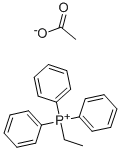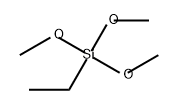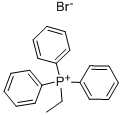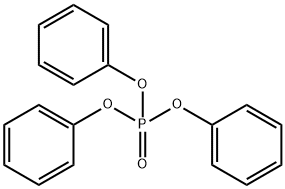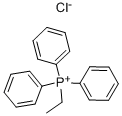Ethyltriphenylphosphonium acetate , 70 , 35835-94-0
CAS NO.:35835-94-0
Empirical Formula: C22H23O2P
Molecular Weight: 350.39
MDL number: MFCD00061389
EINECS: 252-743-7
| Pack Size | Price | Stock | Quantity |
| 100g | RMB1024.00 | In Stock |
|
| 500g | RMB3179.20 | In Stock |
|
| 2.5kg | RMB30061.60 | In Stock |
|
| others | Enquire |
PRODUCT Properties
| Boiling point: | 275℃[at 101 325 Pa] |
| Density | 1.05 |
| vapor pressure | 0Pa at 25℃ |
| Flash point: | -17°(0°F) |
| form | Liquid |
| color | Yellow to dark brown |
| Water Solubility | Soluble in water, alcohol. |
| Exposure limits | ACGIH: TWA 200 ppm; STEL 250 ppm (Skin) OSHA: TWA 200 ppm(260 mg/m3) NIOSH: IDLH 6000 ppm; TWA 200 ppm(260 mg/m3); STEL 250 ppm(325 mg/m3) |
| LogP | -0.64 at 23.5℃ |
| CAS DataBase Reference | 35835-94-0(CAS DataBase Reference) |
| EPA Substance Registry System | Phosphonium, ethyltriphenyl-, acetate (35835-94-0) |
Description and Uses
Ethyltriphenylphosphonium Acetate, also known as ETPAAC, ETPAACc and TEPA, is a colourless to slightly yellow liquid with the chemical formula C22H23O2P. This quaternary phosphonium salt is available in a 70% by-weight solution in methanol. Notably, one mole of acetic acid is bound to each mole of ETPAAC. Furthermore, the material is mainly used for advancing and curing phenolic-based epoxy resins and serving as a phase transfer catalyst. Compared to amines, imidazoles, and quaternary ammonium salts, Ethyltriphenylphosphonium Acetate has considerably better latency and thermal stability. Further, it offers a low odour, minimal colour formation and controlled reactivity.
Ethyltriphenylphosphonium acetate is mainly used to advance and cure phenolic-based epoxy resins and as a phase transfer catalyst. It exhibits considerably better latency and thermal stability when compared to amines, imidazoles and quaternary ammonium salts. Furthermore, it has minimal odour, colour formation, and controlled reactivity. It decreases or eliminates side reactions and creates longer, straighter chain epoxy molecules with sharp molecular weight distribution.
Safety
| Symbol(GHS) |     GHS02,GHS06,GHS07,GHS08 |
| Hazard statements | H225-H301-H311-H315-H319-H331-H335-H370 |
| Precautionary statements | P210-P301+P310a-P303+P361+P353-P305+P351+P338-P405-P501a |
| RIDADR | UN1993 |
| TSCA | Yes |
| HazardClass | 3 |
| PackingGroup | II |

